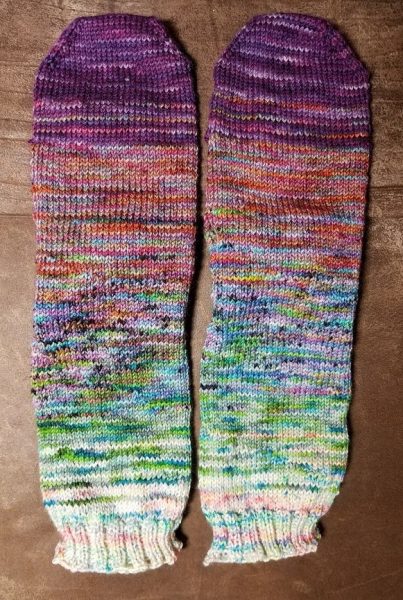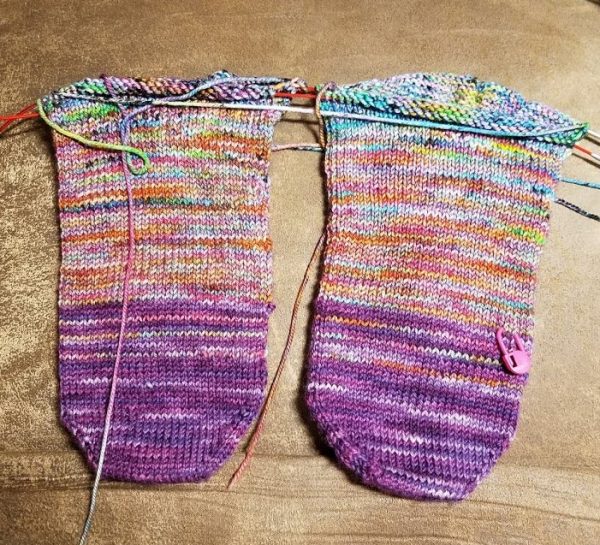As I was planning my fade socks, which I’ve shown already but will include here just to keep a photo with the instructions, I read several blog posts and various instructions about the best way to fade a project.
There are two, or should I say . . at least two, popular methods for fading. The one I used is described below. The other is to use two strands of yarn and fade out. Example: Start with two strands of Color A, work whatever amount you’d like, then drop one strand of A , pick up one strand of B and continue with one strand of A and one strand of B. At some point, drop the A, pick up another B and work with two strands of B til you’re ready to “fade”, then drop one strand of B and pick up one strand of C so you’re knitting with one strand of B and one strand of C and so forth.
This method I use is done with one strand but you begin alternating colors when it’s time to fade. This is the general path I followed. Consider that Color A is the color I’ve just finished working with and Color B is the color I’m about to fade into so, in theory, I’m not saying Colors C, D and E, even though I used five colors. For following along with these instructions, consider A to be the yarn I’m fading away from and B is the yarn I’m fading into.
After having just finished my section of Color A, this is what I did, though you know that I’m not very good at following instructions.
Having done all my research and coming up with my plan only works when the yarn cooperates. In the photo above, you can see that the blending didn’t go so well with my first fade (first above the toe). Color A (the purple toe) was a bit more solid than Color B (the rusty pink). This was my first ever fade and, after having done that, I would have added a couple more Rows of A into B as I eased into the fade.
With the next two fades, the yarn so easily faded that I stopped the fade sequence after Row 11. Making two socks at a time meant four balls of yarn at a time while fading so I was more than happy to cut loose two of those balls as soon as I could.
By the time I got to the final fade (green to white), that was again a pretty big change in color so I went through the whole fade sequence and did much better than I had done with the first fade. There’s still a bit of striping in the green to white fade, but overall, it looks fine and I’m happy with all of them except that first purple fade.
Another thing that you may want to figure out, which I usually don’t worry about when knitting socks, would be your row gauge and the approximate number of rows you will be knitting. It helps to have a “guestimate” as to whether you’re going to be knitting 200 rows or 400 rows (or anything in between).
I know that my row gauge with fingering weight yarn and my preferred 2.25 mm needles is about 11 rows per inch. I know that I like to make the leg of my socks about 8″ from the top of the ribbing to the bottom of the heel flap (so that’s 88 rows) and I know that I knit my foot portion about 6″ before starting the so that’s 66 rows, so, altogether, I’m going to be knitting about 154 rows. Just a bit of quick math . . be patient . . math is your friend – If I’m wanting to use 5 colors of yarn, that’s about 30 rows per color. Of course, all this depends on how many rows you will use to accomplish your fade, but this can be a general formula. Also, you may not want each section to be exactly uniform. Make one wider, one narrower. Don’t overthink or overplan any of this.
Color #1 – Starting with the toe, knit about 20 rows and start your fade. Suppose your fade takes up 15 rows.
Color #2 – Knit about 15 rows. This would put you up to about row 50. You may want to change yarns before getting to the heel. I wouldn’t want to be creating the heel flap and turning it while changing colors.
Continue with that method. If doing toe up, the leg doesn’t have to be a definite length. You can make it however long is comfortable for you or whatever length works out with your color changes.
One last thing . when I’m making socks, I like having at least some amount of nylon content in them but for a fade projet, it may be ok to use a yarn for the leg that doesn’t have nylon – especially if you hand wash your socks.
It’s a fun process. If you’re a sock knitter, I urge you to try a pair of faded socks. If you need a good toe up sock pattern, I highly recommend Sockmatician’s Toe-Ups.
It was a learning experience and something I will definitely do again.


